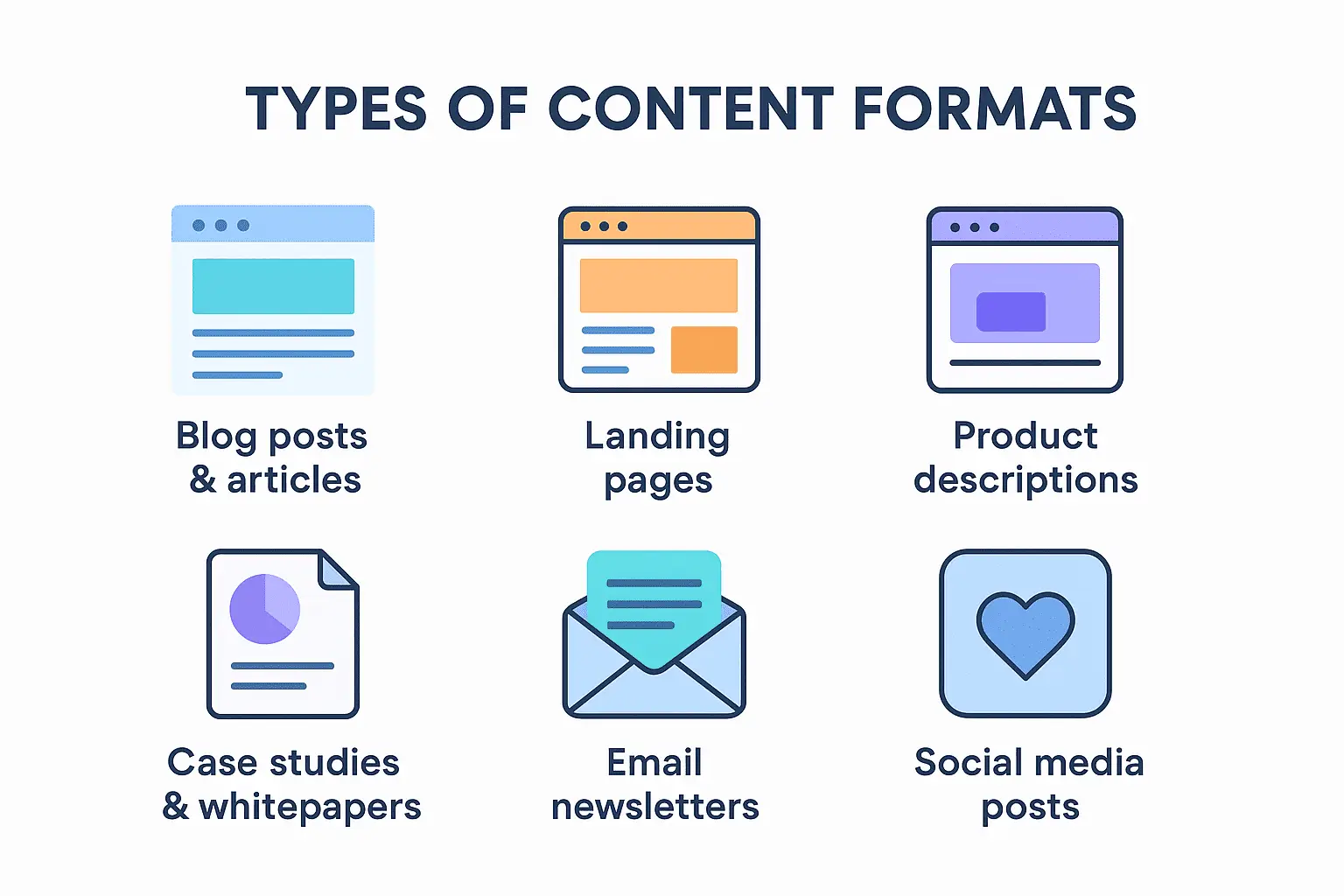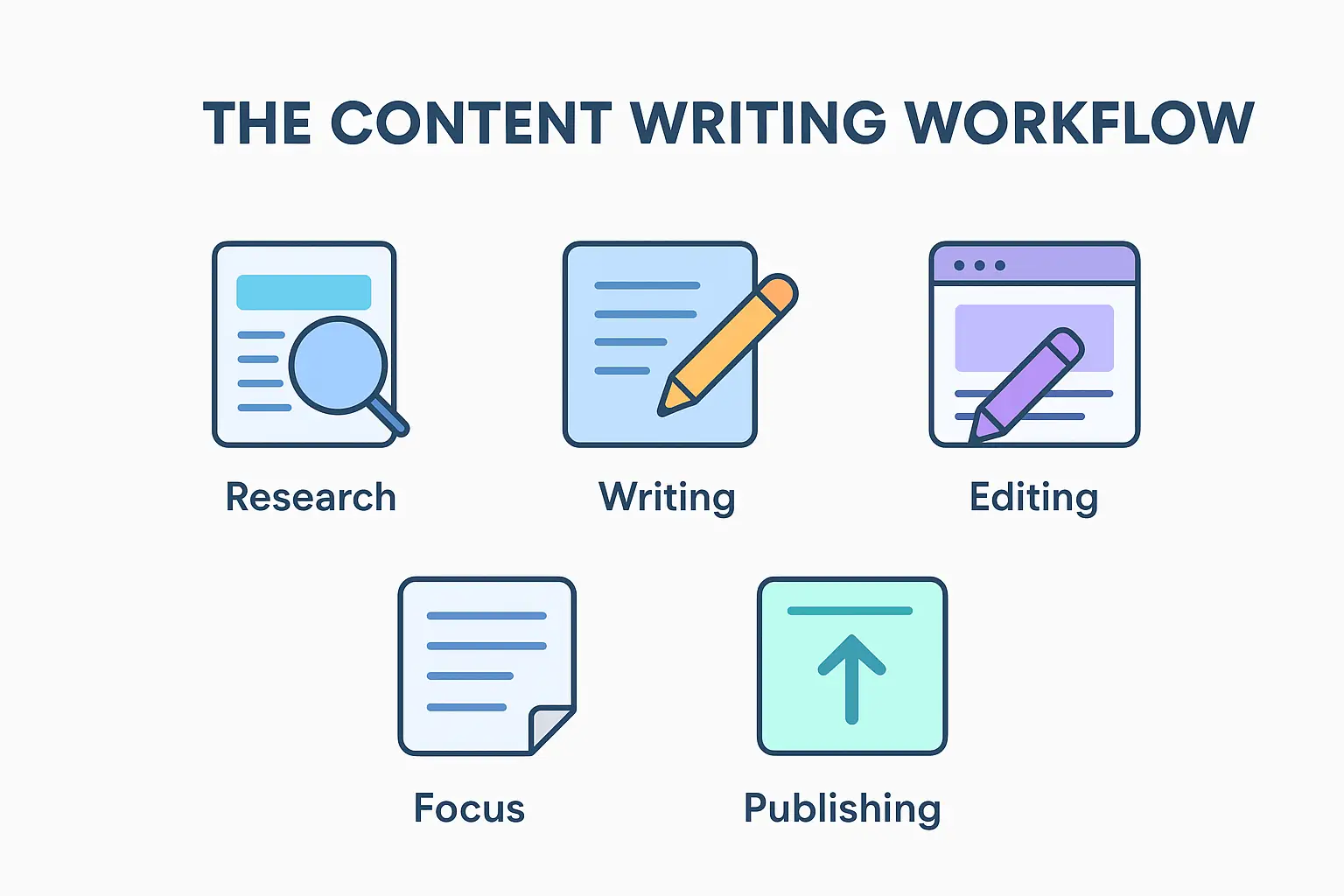What is content writing? Discover formats, workflow, skills & best practices to write SEO-friendly content that drives traffic.
Introduction
Content writing has become one of the most important skills for businesses and creators in the digital age. It goes far beyond just “writing articles.” Done well, content writing shapes how a brand communicates, attracts search traffic, generates leads, and engages customers across different platforms.
In fact, the global content marketing industry is expected to exceed US$107 billion by 2026 . For B2B marketers, 83% say content marketing builds brand awareness, while 77% say it generates demand and leads. That shows the true power of well-structured content writing.
This guide explains everything you need to know about content writing in 2025—from what it is, why it matters, how to do it step-by-step, the skills you need, how AI fits in, and how to measure ROI.
What is Content Writing?
At its core, content writing is the process of planning, creating, and publishing written material for a specific audience, with a clear business or communication goal.
Unlike casual writing, content writing is goal-oriented. It must serve one or more purposes:
- Educate the audience (blogs, whitepapers, guides)
- Attract organic search traffic (SEO articles)
- Persuade readers (landing pages, sales copy)
- Engage communities (social posts, newsletters)
- Support customer journeys (product descriptions, FAQs)
Content Writing vs. Copywriting
- Content writing is broader—long-form, educational, and SEO-driven.
- Copywriting is conversion-focused—ads, CTAs, landing page copy.
Types of Content Formats

- Blog posts & articles
The backbone of most content strategies, blogs educate and inform while attracting organic search traffic. Long-form articles also help build topical authority and showcase expertise. - Landing pages
Conversion-focused pages designed to persuade visitors to take a specific action—sign up, download, or buy. Strong headlines, benefits, and CTAs drive results. - Product descriptions
Concise yet persuasive content highlighting product features, benefits, and use cases. Optimized descriptions boost both SEO visibility and conversions. - Case studies & whitepapers
In-depth, research-backed formats that demonstrate expertise and proof of results. They’re powerful tools for B2B lead generation and trust-building. - Email newsletters
Regular updates sent to subscribers to nurture relationships, share insights, and drive engagement. They often blend educational value with subtle promotional CTAs. - Video scripts & podcast scripts
Pre-written dialogues or outlines that structure engaging audio-visual content. They help ensure clarity, consistency, and storytelling across multimedia formats. - Social media posts
Short, engaging content tailored to platforms like LinkedIn, X (Twitter), or Instagram. Effective for community engagement, brand awareness, and quick call-to-actions.
Why Content Writing Matters in 2025
Content is still king—but quality content is what rules.
- Organic reach & SEO: 70% of people prefer learning about a company via an article instead of ads.
- Brand authority: High-quality, consistent content signals expertise and trust.
- Leads & conversions: B2B content marketing generates 3× more leads than traditional marketing at a lower cost.
- Engagement signals: Google evaluates engagement using CTR, dwell time, bounce rate, and pogo-sticking behaviors.
And content budgets keep growing—46% of B2B marketers plan to increase their budgets to keep up with the demand.
The Content Writing Workflow (Step by Step)
One major gap in competitor blogs is that they don’t show the end-to-end workflow. Here’s the full process:

1. Research & Planning
- Identify target keywords (use Google keyword planner, keywordly.ai)
- Map search intent: informational, commercial, transactional.
- Analyze competitors’ SERP content.
- Collect entities and FAQs to include.
2. Create a Content Brief
- Include: keywords, H1/H2/H3 outline, meta title/description, target audience, internal links, target word count.
Read this article on how to create seo content briefs that make scaling easier.
3. Outline & Structure
- Build a skeleton with H2s and H3s.
- Ensure scannability (lists, bullet points, bold).
4. Drafting
- Write in brand voice.
- Keep sentences short.
- Use data and examples.
- Prioritize readability (Flesch 60+).
- Add accessibility (alt text, headings).
5. On-Page SEO
- Optimize H1, meta title (60 chars), meta description (155 chars).
- Add schema (FAQ, HowTo, Article).
- Include OG tags for social sharing.
6. Review & Edit
- Proofread grammar.
- Fact-check.
- Add sources for E-E-A-T.
7. Publish & Distribute
- Start by publishing a detailed blog, then share it with your email subscribers for direct engagement. Break it down into LinkedIn posts and bite-sized social snippets, and finally repurpose the key points into visual shorts or carousels to maximize reach across platforms.
- 90% of marketers use social, 73% email newsletters, 63% paid promotion.
8. Measure & Refresh
- GA4 events: scroll depth, CTA clicks, conversions.
- Refresh content every 6–12 months.
Core Skills Every Content Writer Needs
- Research & analysis
- SEO fundamentals
- Storytelling & voice
- Grammar & clarity
- Adaptability across formats
- AI literacy for writing assistance
Content Writing Best Practices
- Write for humans, optimize for search.
- Keep paragraphs short (2–3 lines).
- Use credible sources (link to authority sites).
- Add visuals + descriptive alt text.
- Use clear CTAs.
- Ensure accessibility compliance (contrast, headings).
The Role of AI in Content Writing (2025 & Beyond)
- Recent data shows that AI has become a mainstream tool in content writing, but its usage varies by stage of the workflow. Around 50% of B2B marketers now use AI for brainstorming, helping them quickly generate content ideas, angles, and headlines without starting from scratch.
- Roughly 45% rely on AI for draft writing, allowing them to speed up the first-draft stage and focus more on refining the content for quality. Interestingly, only 20–23% currently use AI for proofreading and outlining , suggesting that while AI is strong in ideation and drafting, most writers still trust manual editing and strategic outlining for accuracy, creativity, and maintaining brand voice.
- This shows AI is a tool, not a replacement.
Where AI Helps
- Topic ideation
AI tools can analyze trends, search data, and audience behavior to suggest fresh, relevant topics. This saves time and ensures content ideas align with what readers are actively searching for. - Draft generation
Instead of starting from a blank page, AI can create structured first drafts based on prompts or briefs. Writers can then refine these drafts to match brand voice, accuracy, and originality. - Repurposing into new formats
AI makes it easier to transform a blog post into social captions, email sequences, or even video scripts. This helps scale distribution while keeping messaging consistent across platforms.
Know more about Content writing tools to consider for AI content writing.
Measuring Content Writing Success (ROI Framework)
How do you know if your content is truly bringing value? It’s not just about publishing consistently—it’s about understanding how your content performs against business goals. By tracking the right ROI-focused metrics, you can see whether your writing is driving awareness, engagement, and conversions. These insights help refine strategy, prove value to stakeholders, and ensure your efforts contribute directly to growth.
Metrics to Track
73% of marketers use these metrics
- Conversions
The ultimate measure of content effectiveness—whether it’s sign-ups, downloads, or purchases. Tracking conversions shows how well your content drives tangible business results. - Email engagement
Metrics like open rates, click-through rates, and replies reveal how effectively your email content nurtures relationships and keeps subscribers interested. - Website traffic & engagement
Analyzing page views, dwell time, and bounce rate helps determine if your content attracts the right audience and keeps them engaged. High engagement signals authority to search engines. - Social analytics
Likes, shares, comments, and reach show how well your content resonates on social platforms. Social performance also indicates content’s shareability and potential for brand amplification.
Examples of Great Content Writing
- Blog Example: HubSpot’s “What Is Content Writing?” blog (well-structured, SEO-friendly).
- Landing Page Example: Apple product pages (benefit-driven, minimal but persuasive).
- Product Page Example: Amazon listings (SEO + conversion-driven).
Future of Content Writing
- AI + human co-creation
The future of content isn’t AI replacing writers—it’s collaboration. AI will handle repetitive tasks like drafting and repurposing, while humans ensure originality, creativity, and emotional depth. - Multilingual & localized content
As brands go global, writing will need to adapt to multiple languages and local cultures. Localized storytelling builds trust and connects with audiences more authentically than generic, one-size-fits-all content. - Voice search optimization
With the rise of smart speakers and voice assistants, content must be structured for conversational queries. Short, direct, and natural-sounding answers will help capture voice search traffic. - Interactive formats (shorts, carousels, AI chatbots)
Static blogs won’t be enough. The future lies in interactive formats—short-form videos, swipeable carousels, and AI-powered chatbots—that make content engaging, personalized, and easy to consume across platforms.
Conclusion
Content writing in 2025 isn’t just about “putting words together.” It’s about research + creativity + SEO + workflow + distribution + measurement.
The data proves: content remains one of the highest-ROI marketing investments, but only when it’s strategic, measurable, and high-quality.
👉 Want to get started today?
Try our free Content Brief & Content Writing Generator to plan, draft, and publish professional content from day one.
FAQs
What does a content writer do?
A content writer researches, plans, drafts, and optimizes content for different formats (blogs, landing pages, newsletters) to attract and engage audiences.
How is content writing different from copywriting?
Copywriting is conversion-focused (ads, CTAs), while content writing is broader (educational, SEO, storytelling).
Do I need SEO skills to be a content writer?
Yes, SEO basics are essential—keyword research, meta tags, internal links, and readability.
Can AI replace content writers?
No. AI helps with brainstorming and drafting, but writers ensure originality, brand voice, and accuracy.
